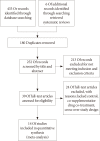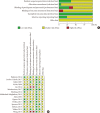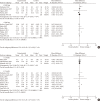Effects of Omega-3 Supplementation on Adipocytokines in Prediabetes and Type 2 Diabetes Mellitus: Systematic Review and Meta-Analysis of Randomized Controlled Trials
- PMID: 29676540
- PMCID: PMC5911513
- DOI: 10.4093/dmj.2018.42.2.101
Effects of Omega-3 Supplementation on Adipocytokines in Prediabetes and Type 2 Diabetes Mellitus: Systematic Review and Meta-Analysis of Randomized Controlled Trials
Erratum in
-
Erratum: Type of Manuscript Correction. Effects of Omega-3 Supplementation on Adipocytokines in Prediabetes and Type 2 Diabetes Mellitus: Systematic Review and Meta-Analysis of Randomized Controlled Trials.Diabetes Metab J. 2018 Aug;42(4):353. doi: 10.4093/dmj.2018.0133. Diabetes Metab J. 2018. PMID: 30136455 Free PMC article.
Abstract
Background: The objective of this systematic review and meta-analysis was to determine the effects of omega-3 supplementation on adipocytokine levels in adult prediabetic and diabetic individuals.
Methods: We searched PubMed, Medline, EMBASE, Scopus, Web of Science, Google Scholar, Cochrane Trial Register, World Health Organization Clinical Trial Registry Platform, and Clinicaltrial.gov Registry from inception to August 1, 2017 for randomized controlled trials. Pooled effects of interventions were assessed as mean difference using random effects model. We conducted a sensitivity, publication bias and subgroup analysis.
Results: Fourteen studies individuals (n=685) were included in the meta-analysis. Omega-3 supplementation increased levels of adiponectin (0.48 μg/mL; 95% confidence interval [CI], 0.27 to 0.68; P<0.00001, n=10 trials), but effects disappeared after sensitivity analysis. Tumor necrosis factor α (TNF-α) levels were reduced (-1.71; 95% CI, -3.38 to -0.14; P=0.03, n=8 trials). Treatment duration shorter than 12 weeks was associated with greater reduction than longer treatment duration. Levels of other adipocytokines were not significantly affected. Publication bias could generally not be excluded.
Conclusion: Eicosapentaenoic acid and docosahexaenoic acid supplementation may increase adiponectin and reduce TNF-α levels in this population group. However, due to overall study heterogeneity and potential publication bias, a cautious interpretation is needed.
Keywords: Adipokines; Diabetes mellitus; Fatty acids, omega-3.
Copyright © 2018 Korean Diabetes Association.
Conflict of interest statement
No potential conflict of interest relevant to this article was reported.
Figures











Similar articles
-
Exercise Increases Adiponectin and Reduces Leptin Levels in Prediabetic and Diabetic Individuals: Systematic Review and Meta-Analysis of Randomized Controlled Trials.Med Sci (Basel). 2018 Oct 30;6(4):97. doi: 10.3390/medsci6040097. Med Sci (Basel). 2018. PMID: 30380802 Free PMC article. Review.
-
The Effect of Omega-3 on Circulating Adiponectin in Adults With Type 2 Diabetes Mellitus: A Systematic Review and Meta-Analysis of Randomized Controlled Trials.Can J Diabetes. 2018 Oct;42(5):553-559. doi: 10.1016/j.jcjd.2017.12.002. Epub 2018 Jan 4. Can J Diabetes. 2018. PMID: 29567080
-
Effect of omega-3 fatty acids supplementation on adipokines: a systematic review and meta-analysis of randomized controlled trials.Crit Rev Food Sci Nutr. 2022;62(27):7561-7575. doi: 10.1080/10408398.2021.1915743. Epub 2021 May 17. Crit Rev Food Sci Nutr. 2022. PMID: 33998914
-
Meta-analysis and meta-regression of omega-3 polyunsaturated fatty acid supplementation for major depressive disorder.Transl Psychiatry. 2016 Mar 15;6(3):e756. doi: 10.1038/tp.2016.29. Transl Psychiatry. 2016. PMID: 26978738 Free PMC article.
-
Alpha-lipoic acid effect on leptin and adiponectin concentrations: a systematic review and meta-analysis of randomized controlled trials.Eur J Clin Pharmacol. 2020 May;76(5):649-657. doi: 10.1007/s00228-020-02844-w. Epub 2020 Feb 10. Eur J Clin Pharmacol. 2020. PMID: 32040596
Cited by
-
Beneficial Effects of Adiponectin on Glucose and Lipid Metabolism and Atherosclerotic Progression: Mechanisms and Perspectives.Int J Mol Sci. 2019 Mar 8;20(5):1190. doi: 10.3390/ijms20051190. Int J Mol Sci. 2019. PMID: 30857216 Free PMC article. Review.
-
The Role of Adiponectin and ADIPOQ Variation in Metabolic Syndrome: A Narrative Review.Genes (Basel). 2025 Jun 10;16(6):699. doi: 10.3390/genes16060699. Genes (Basel). 2025. PMID: 40565591 Free PMC article. Review.
-
The Effect of Omega-3 Fatty Acid Supplementation on Serum Adipocytokines, Lipid Profile and Biochemical Markers of Inflammation in Recreational Runners.Nutrients. 2021 Jan 29;13(2):456. doi: 10.3390/nu13020456. Nutrients. 2021. PMID: 33573042 Free PMC article. Clinical Trial.
-
Evaluation of walking exercise on glycemic control in patients with type 2 diabetes mellitus: A protocol for systematic review and meta-analysis of randomized cross-over controlled trials.Medicine (Baltimore). 2020 Nov 20;99(47):e22735. doi: 10.1097/MD.0000000000022735. Medicine (Baltimore). 2020. PMID: 33217794 Free PMC article.
-
The Influence of Nutrition on Adiponectin-A Narrative Review.Nutrients. 2021 Apr 21;13(5):1394. doi: 10.3390/nu13051394. Nutrients. 2021. PMID: 33919141 Free PMC article. Review.
References
-
- World Health Organization. Diabetes fact sheet. [cited 2018 Apr 9]. Available from: http://www.who.int/mediacentre/factsheets/fs312/en.
-
- Eckel RH, Kahn SE, Ferrannini E, Goldfine AB, Nathan DM, Schwartz MW, Smith RJ, Smith SR Endocrine Society; American Diabetes Association; European Association for the Study of Diabetes. Obesity and type 2 diabetes: what can be unified and what needs to be individualized? Diabetes Care. 2011;34:1424–1430. - PMC - PubMed
-
- World Health Organization (WHO) Obesity and overweight fact sheet. [cited 2018 Apr 9]. Available from: http://www.who.int/mediacentre/factsheets/fs311/en.
-
- Bertoni AG, Krop JS, Anderson GF, Brancati FL. Diabetes-related morbidity and mortality in a national sample of U.S. elders. Diabetes Care. 2002;25:471–475. - PubMed
Publication types
LinkOut - more resources
Full Text Sources
Other Literature Sources

